
Hillman Becomes Basketball Town, Too
January 6, 2017
By Dennis Chase
Special for Second Half
HILLMAN – Eric Muszynski still remembers that day in 2005 when, as the newly appointed boys basketball coach at Hillman, he made a promise to the man who hired him, administrator Jack Richards.
 As they gazed at the banners in the school gymnasium – highlighted by the school’s three MHSAA Class D championships in baseball – Muszynski vowed to add some basketball banners to the collection.
As they gazed at the banners in the school gymnasium – highlighted by the school’s three MHSAA Class D championships in baseball – Muszynski vowed to add some basketball banners to the collection.
“He (Richards) chuckled,” Muszynski recalled. “He said, ‘Try to get to .500 first.’”
Historically, Hillman’s been a baseball town. The Tigers played for MHSAA championships four times in six years during the 1990s.
“Basketball was something you did to stay in shape for baseball,” said Richards, who went on to serve as superintendent for five years. “Eric’s turned that around.”
Since 2009, Hillman has won four North Star Conference basketball championships, five Districts and one Regional. The Tigers stretched their regular-season win streak to 44 after Thursday night’s 68-38 victory over Mio. Their last regular-season loss was to Cedarville in the 2014-15 opener.
Quite a turnaround for a program that had won only one league title prior to Muszynski’s arrival.
“And that wasn’t an outright title,” senior guard Gunnar Libby said.
Libby, a first-team Associated Press all-state pick last season, is the catalyst for this 5-0 Tigers team. A four-year varsity veteran, Libby has played a vital role in the program’s growth. Hillman won its first outright league title when he was a freshman, captured its first Regional crown when he was a sophomore, and posted its first unbeaten regular season when he was a junior.
“I’ve been really lucky to play on some good teams,” he said.
The turnaround did not happen overnight. The Tigers were 10-32 in Muszynski’s first two years.
“I remember thinking to myself, ‘Will we ever get over that hump?’” Muszynski wondered.
His boss stood by him.
“I had some people come to my office, saying he wasn’t the guy for the job,” Richards said. “I told them, ‘Settle down. This guy will bring us championships.’ Eric heard me, and he took it to heart. He worked hard to prove me right.”
In his third season, Muszynski led Hillman to an 11-10 mark. From there, the program took off.
“It’s been truly amazing,” the former Alpena High School standout said. “As a coach, you envision and hope that your program can do big things. We’ve been in that conversation – of trying to get down to East Lansing (for the Final Four) – since 2013 when we almost upset Cedarville (a double overtime loss) in the Regional Final.”
Hillman, sparked by Mason VanPamel and Ty Jones, reached the Quarterfinals in 2015 before losing to eventual champion Powers North Central.
It looked like the Tigers might be in for a rebuild last season, losing eight seniors and four starters to graduation. Instead, Hillman won its first 22 games before losing to Onaway 58-57 in the District Final.
“We were counted out from the very beginning,” Libby said. “We proved everybody wrong.”
Still, the setback to Onaway – a team Hillman had knocked out of the Districts the previous three years – left a bitter taste. Onaway reached the Quarterfinals, but that loss motivates the Tigers.
When his team first gathered for practice this season, Muszynski stressed the importance of “protecting” its league title as well as recapturing the District championship. Hillman had won three Districts in a row before its sudden exit last March.
“That District (trophy) should be in Hillman,” Libby said.
That statement reflects how far this program has evolved. It’s a program that’s now won 46 consecutive league games and 36 consecutive home games.
Those streaks continue to grow, although Libby admitted he’s lost count.
“You just go out there and do what you’ve got to do,” he said.
The 5-foot-9 Libby is the floor general and lone senior in the starting lineup. He averages 25 points and six assists per game. He surpassed 1,000 career points in the season opener when he dropped 30 on Cedarville.
“He’s lightning quick,” Muszynski said. “He’s a tough kid; a hard-nosed, old school style point guard.”
Libby’s backcourt mate, 5-10 junior Brandon Banks, averages nearly 15 a game.
“That’s been our recipe for success since 2009,” Muszynski said. “We usually feature two dynamic scorers.”
Andrew Funk, a 6-foot junior, is also averaging in double figures. He scored 19 in Tuesday’s win, hitting five of Hillman’s 13 3-pointers.
The Tigers compensate for lack of size with speed, a trapping defense and a dangerous perimeter game. Kory Henigan, a 6-4 sophomore, and Billy Kolcan, a 6-1 junior, are the tallest starters. Henigan averages eight points and seven rebounds while the athletic Kolcan, an MHSAA Finals qualifier in track and an honorable mention all-state player in football, spearheads the press.
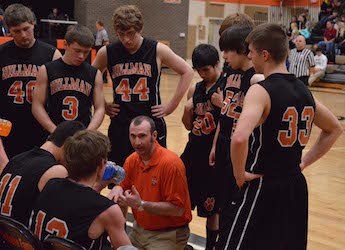 “He (Kolcan) plays up front on our press,” Muszynski said. “He makes us go. He’s one of the best athletes to come through our school in a long time.”
“He (Kolcan) plays up front on our press,” Muszynski said. “He makes us go. He’s one of the best athletes to come through our school in a long time.”
Kolcan, Banks and Funk were on varsity as sophomores last season.
“On paper, it appears we’re young,” Muszynski said. “But we’re battle-tested.”
And, according to Libby, cohesive, too.
“We work well together,” Libby said. “We’re unselfish – and we scrap.”
Now, the Tigers would like to start playing more basketball. Hillman played just three games in December after two contests were postponed due to weather.
“It’s hard to get any kind of rhythm and consistency when you play two games, then you’re off two weeks, you play one game, then you’re off another two weeks,” Libby said.
As for Muszynski, this is his 12th season at Hillman. He was hired as a physical education/health/social studies teacher and girls basketball coach. When the boys job opened soon afterward, he added that to his responsibilities. He coached both teams for two years before the MHSAA switched girls basketball season to the winter. Even though the girls were 30-12 in those two seasons under his leadership, he felt coaching boys basketball was his calling.
“I liked the challenge,” he said. “With the girls, I walked into a good program. With the boys, I wanted to see if I could build a program.”
With a win over Rudyard just before the holiday break, the 37-year-old Muszynski notched his 200th career win at Hillman (30 with the girls, 170 with the boys).
“He’s been a real blessing for us,” Libby said. “He’s a great coach. He holds us all accountable. He’s thorough, and he can motivate. He knows his stuff.”
“I’m truly blessed,” Muszynski added. “That’s (200 wins) a credit to my players, past and present.”
Muszynski echoed those same sentiments after he won the Associated Press Class D Coach of the Year honor last season.
“One of the proudest moments in my coaching career,” he admitted. “Not only was it a great reward, but it was a reflection of our basketball program here.”
Richards, meanwhile, takes satisfaction in the basketball program’s accomplishments. Now retired, he still follows the Tigers – and Muszynski.
What did he see in Muszynski when he hired him in 2005?
“He has a drive,” Richards said. “He knows what it takes and the work that’s involved. A lot of people just want to work during the season, and when it’s over they’re done. That’s not Eric. He’s a worker, a planner. You could see his desire.”
Richards also feared, once the boys started winning, that Muszynski might leave for a bigger school. He even mentioned that to Muszynski.
“Eric said, ‘You gave me the opportunity to be a head coach and I want to do right by you,’” Richards recalled. “I said, ‘I understand that. But let me give you a piece of advice: it’s easier to build a dynasty in a small town than in a large town.’ I think he’s done a pretty good job with that.”
Muszynski looked north to Cedarville for inspiration. Coach Dave Duncan developed that program into a state contender. The Trojans won an MHSAA title in 2007 and nearly another two years later.
“I thought if a small Class D school in the Upper Peninsula can do that, why can’t we?” Muszynski reasoned.
One of Muszynski’s first priorities was to start applying his philosophies in the youth program so by the time those players reached the varsity they would know the defensive schemes and offensive sets.
“They’ve seen success so they know the formula works,” Muszynski said. “If you have some success, and start to win championships, everyone starts to buy in.”
As for baseball? Practice is still several weeks away.
“When I first got there,” Richards recalled, “the kids, after basketball practice, would put their gloves on and throw the baseball around. They even had a batting cage in the old gym. Now, you don’t see a baseball glove in the gym during the winter.”
Now you see basketball banners.
 Dennis Chase worked 32 years as a sportswriter at the Traverse City Record-Eagle, including as sports editor from 2000-14. He can be reached at [email protected] with story ideas for Manistee, Wexford, Missaukee, Roscommon, Ogemaw, Iosco, Alcona, Oscoda, Crawford, Kalkaska, Grand Traverse, Benzie, Leelanau, Antrim, Otsego, Montmorency, Alpena, Presque Isle, Cheboygan, Charlevoix and Emmet counties.
Dennis Chase worked 32 years as a sportswriter at the Traverse City Record-Eagle, including as sports editor from 2000-14. He can be reached at [email protected] with story ideas for Manistee, Wexford, Missaukee, Roscommon, Ogemaw, Iosco, Alcona, Oscoda, Crawford, Kalkaska, Grand Traverse, Benzie, Leelanau, Antrim, Otsego, Montmorency, Alpena, Presque Isle, Cheboygan, Charlevoix and Emmet counties.
PHOTOS: (Top) Gunnar Libby, who has scored more than 1,000 points during his Hillman career, cuts through a group of defenders. (Middle) Hillman coach Eric Muszynski addresses his team. (Photos courtesy of The Alpena News.)
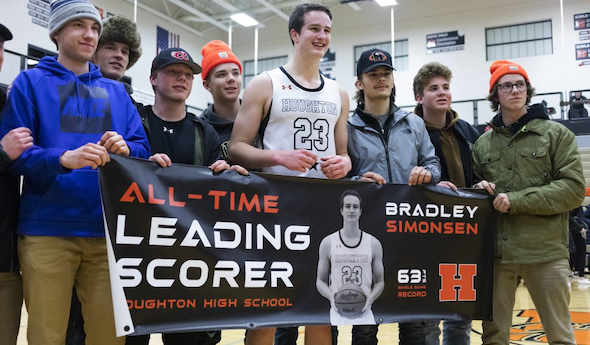
63-Pointer Stirs Memories of UP Legends
February 29, 2020
By Ron Pesch
Special for Second Half
For the first time since 1970 – 50 years ago – and for only the 10th time in Upper Peninsula boys basketball history, a player has scored 60 or more points in a single game.
And that Houghton showing has stoked memories of legendary U.P. scoring showcases going back more than a century.
For the first time, the effort was for naught, at least from a win-loss standpoint, as Houghton dropped a nonconference road contest to Ishpeming 88-83 on Feb. 4. Brad Simonsen hit 23 of 45 field goal attempts, including 7 of 18 from beyond the 3-point arc, as Houghton pushed the play, hoping to narrow what had been a 10-point halftime margin. The 6-foot-6 senior, signed by Michigan Tech, was 10 of 13 from the free throw line and scored 24 points in the fourth quarter, ending the night with 63.
The performance topped Houghton’s school record of 60 points, set by Gary Lange in 1970. The total ranks 14th across the entire state for single game points in a contest, and tied Simonsen for sixth highest above the bridge. There, the mark equaled the top single-game output posted by Stephenson’s Mel Peterson, considered by many the greatest cager ever to come out of the Upper Peninsula.
“Marvelous Mel”
Peterson was the son of a minister and one of 10 children (and eight boys). His older brother, George, broke the U.P. scoring record in 1949 with 44 points in a game for Stephenson High School. The family moved away from the Upper Peninsula following George’s graduation, ultimately landing in southeastern Idaho.
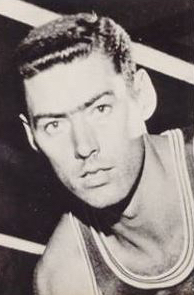 There, Mel emerged as an outstanding athlete for Idaho Falls High School. Standing 6-foot-4½, Peterson’s growth occurred mostly during his freshman year.
There, Mel emerged as an outstanding athlete for Idaho Falls High School. Standing 6-foot-4½, Peterson’s growth occurred mostly during his freshman year.
“I played quite a bit on the varsity my sophomore year,” recalled Peterson recently. “My junior year I started out very, very slow but ended up very good. (However,) I fractured my ankle with about a minute to go in the semifinals of the (1955) state tournament, which we won.”
Peterson led all scorers with 25 points and dominated the boards that night, but had to be helped from the floor, then didn’t play in the title contest. “We lost the state tournament by three points, (43-40 to Kellogg). I was a cheerleader. … It would have been fun to play in the final game.”
When his father received a call to serve the Mission Covenant Church in Wallace, Michigan, about seven miles south of Stephenson, the family returned to the Upper Peninsula for Peterson’s senior year.
“At that time, it was nothing like it is now, where you can find anything about anybody. Then, that wasn’t the case at all,” Peterson said. “So, when we came back, no one had any idea of where I lived before, if I played or not.”
Indeed, prior to football season, one newspaper report indicated Peterson had transferred in from North Dakota, while another listed him as coming from Illinois. Regardless, Peterson emerged as a solid football player at Stephenson High in the fall of 1955. But it was on the basketball court where his scoring and rebounding prowess quickly loomed. He opened the season with 33 points in a win over Gladstone, despite fouling out early in the fourth quarter.
By January, the media had taken to calling him “Marvelous Mel” as Peterson averaged 32.3 points in his first half-dozen games for the Eagles. He drove Stephenson to a 15-1 regular-season record, posting 11 games over 30 points and scoring more than 40 in six.
On Jan. 21, 1956, he poured in 63 points in an 89-44 win over Manistique, shattering his brother’s school record. Mel nailed 25 of 38 shots from the field and 13 of 16 from the free-throw line. At the time, the scoring total exceeded the previous known best in the U.P. of 60 points, scored by Norbert Purol in February 1952. (Purol, from Ironwood St. Ambrose, would later play two seasons of AAU ball in Chicago before matriculating at Kentucky Wesleyan, earning four letters between 1956 and 1959. Wesleyan ended the 1957 season as runner-up to Wheaton College in the inaugural NCAA Small College Tournament – now known as Division II.)
“I don’t remember a great deal about a lot of it. That was so long ago,” said Peterson, laughing. “I guess the thing I appreciate most about the game was that my coach (Duane “Gus” Lord), let me play the whole game, which didn’t happen real often. Probably the thing I remember most about the whole year is that we played a Catholic school, Lourdes, from Marinette, Wisconsin. The first game we played them we beat them 110 to 44. The second game we lost 68-66.”
Peterson’s regular-season total of 570 points also exceeded Purol’s U.P. record of 556 posted over 19 games in 1952. His regular-season average, which had climbed to 35.6, topped the previous best of 29.6, posted by Pete Kutches in 1952 for Escanaba St. Joseph. Then Peterson pushed the per-game-average even higher in the postseason.
Seeing more playing time in the playoffs, “Marvelous Mel,” notched more than 30 points in all seven postseason games (exceeding 40 in three of the contests and 50 once), leading Stephenson to the MHSAA Class B championship win against Detroit St. Andrews in sudden-death overtime, 73-71. There he scored the game-tying bucket with 17 seconds remaining in the three-minute extra frame, and then sunk the game winner 26 seconds into sudden death, where the first team to gain a two-point advantage was proclaimed the victor. That 1956 season saw three of the four basketball championships awarded to U.P. teams.
Peterson finished with 849 points on the year – at the time the best single-season performance in MHSAA history. He averaged 36.9 points across 23 contests – currently eighth in the MHSAA record book.
Following graduation, Peterson nearly signed to play at the University of Minnesota, but felt a better fit at Wheaton College, outside Chicago. There, he earned three All-American honors. As a freshman in 1957, he led Wheaton to victory in that first NCAA Small College Tournament championship game against Wesleyan, earning Most Outstanding Player honors along the way. Today, he remains Wheaton’s all-time leader in career points, points per game, field goals made and career rebounds, all accomplished “without the benefit of a 3-point line, which had yet to be implemented.”
Peterson, who helped the USA team win gold at the 1963 Pan American Games in Sao Paulo, Brazil, played two games for Baltimore in the National Basketball Association (NBA) before a heart condition sidetracked his career. Once the issue was repaired, he returned to play 134 games over three seasons in the American Basketball Association, earning an ABA league championship with the Oakland Oaks in 1969. In 2019, he was inducted into the Small College Basketball National Hall of Fame.
The High-Scoring Sixties
Roger Roell, a senior at Channing, topped Peterson’s U.P. single game record with a 67-point performance in early January 1960 by dropping 31 field goals and five free throws in a 105-55 win over Michigamme.
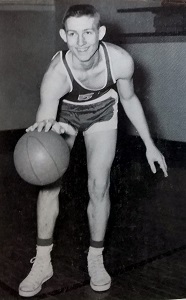 Just over seven weeks later, Jim Manning scored 69 for Trout Creek against Amasa in another lopsided affair, 140-47 (then, a U.P. record for highest team score. The team’s 44 points in the fourth quarter was also a U.P. mark at the time. Trout Creek’s coach, Bruce Warren began substituting in the second quarter).
Just over seven weeks later, Jim Manning scored 69 for Trout Creek against Amasa in another lopsided affair, 140-47 (then, a U.P. record for highest team score. The team’s 44 points in the fourth quarter was also a U.P. mark at the time. Trout Creek’s coach, Bruce Warren began substituting in the second quarter).
Manning, a junior, finished the 1959-60 season as the first player in U.P. history to exceed 600 points in one regular season, totaling 608 over 18 games. He would later pitch in the Major Leagues.
Roell finished second with 569 points in 18 regular-season contests. Third on the regular-season scoring list was another junior, Erwin Scholtz of Hermansville, who tallied 505 across 18 games.
As a senior, the 6-foot-5 Scholtz would post 71 points against Channing, a new benchmark for points in a game in the Upper Peninsula.
Or was it?
The Master’s Thesis
Perhaps because of the media coverage of Scholtz’s accomplishment, in 1962 the Crystal Falls Diamond Drill ran an article detailing the recently unearthed exploits of Ed Burling some 50 years prior. Richard Mettlach, football and baseball coach at Crystal Falls, had uncovered the Burling story.
Mettlach, “in the process of preparing a history of local high school sports which he submitted as a part of the preparation for his master’s degree … discovered that the newspaper records of the early years of high school basketball tell of a match between Iron River and Crystal Falls (played during the 1910-11 season).”
Crystal Falls had downed Iron River, 107-27, according to Mettlach’s research, and Burling had scored all but 10 of Crystal Falls’ points.
“Basketball was different in those days,” said Burling when interviewed by the Diamond Drill in January 1962. Then 68 years old and working as the postmaster in Crystal Falls, he recalled, “when one man was hitting the basket well, the rest of the team fed him the ball and let him shoot. I couldn’t miss that night.”
According to the article, “Burling said as he recalled the game, he made 98 points that night. It appears that 97, however, reportedly verified in two newspaper accounts of the game, will have to be the figure used in the record book.”
Burling recalled that the majority of his shots were from in front of the basket and that rules of the day allowed the top shooter on the team to attempt the free throws.
“The 97 point scoring record would probably have never been uncovered if it had not been for Mettlach’s research,” added the Diamond Drill.
Three more U.P. additions
In 1966, Bob Gale of Trout Creek scored 60 against Mercer, Wisconsin. Gale would later play at Michigan State.
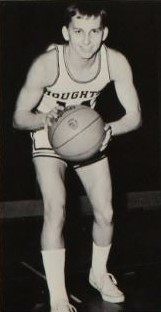 Houghton’s Lange scored his 60 as the Gremlins walloped Painsedale Jeffers, 134-62, on January 23, 1970. One week later, Larry Laitala dropped 65 as Champion crushed Felch, 114-71.
Houghton’s Lange scored his 60 as the Gremlins walloped Painsedale Jeffers, 134-62, on January 23, 1970. One week later, Larry Laitala dropped 65 as Champion crushed Felch, 114-71.
“We had a very good team that year. We had a lot of wings and normally, I wouldn’t play the whole game. My coach was Dominic Jacobetti (who played at Negaunee St. Paul, then Northern Michigan University) and he was a pretty prolific scorer in the U.P. It was one of those nights where the rim was real big,” recalled Laitala, chuckling.
Laitala finished second to Lange in regular-season scoring, 557 to 523, with each athlete playing 17 games.
“Houghton is possibly the best team in any class in the Upper Peninsula,” wrote Hal Schram in the Detroit Free Press, who predicted an MHSAA state title for the team noting that many felt Lange was the top player north of the bridge. The Gremlins, at 17-0, finished as the top-ranked team in Class C in the weekly press polls assembled by the Free Press, The Associated Press and United Press International.
But the season ended earlier than expected for both teams. Houghton fell to St. Ignace in a Regional Semifinal.
“We were beat by our archrival, Republic (61-55) in the first game of the (Class D) Districts, which was kind of an upset,” added Laitala.
Prior to Simonsen’s accomplishment, Lange and Laitala were the most recent players above the Straits of Mackinac to equal or exceed the 60-point minimum established in the MHSAA record book.
The Challenge of Traceability
With modern-day electronic archiving of a number of the state’s newspapers and the accessibility of newspapers on microfilm, an effort has been made to add dates to single-game records, where once only the season of accomplishment was listed. The work continues.
Today, more than 100 years later, the “two newspaper accounts” used back in the 1960s for verification of Burling’s scoring accomplishment have not resurfaced. Hence, neither the date of the game, nor details from period accounts are available for study. That, combined with knowledge that basketball games from the time were usually low-scoring affairs, means doubt is still cast on the mark.
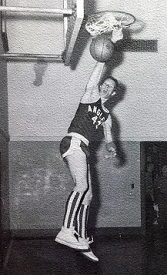 After investigation, the record was accepted by Crystal Falls historian Malcolm McNeil and U.P. sports archivist, Jim Trethewey, a former sports editor of the Marquette Mining Journal who travelled to Crystal Falls to interview Burling. MHSAA historian Dick Kishpaugh ultimately added the performance to the state record book. Questions about the legitimacy of Burling’s total began almost immediately and have resurfaced every 10 years or so. Todd Schulz, a former sports columnist at the Lansing State Journal, wrote extensively on the chase in 2012.
After investigation, the record was accepted by Crystal Falls historian Malcolm McNeil and U.P. sports archivist, Jim Trethewey, a former sports editor of the Marquette Mining Journal who travelled to Crystal Falls to interview Burling. MHSAA historian Dick Kishpaugh ultimately added the performance to the state record book. Questions about the legitimacy of Burling’s total began almost immediately and have resurfaced every 10 years or so. Todd Schulz, a former sports columnist at the Lansing State Journal, wrote extensively on the chase in 2012.
One of the individuals still working to help solve the mystery is Al Anderson of Crystal Falls.
The Diamond Drill was a weekly paper during Burling’s high school days, and newspapers of the time generally didn’t separate prep sporting news into sections. When reported upon, accounts of high school games were usually included in a ‘School Notes’ column.
The season was, without question, a success. “Winning eight out of ten games played, and having three challenges refused, the local basket ball team lay claim to the U.P. championship for the season of 1910-11,” stated the Diamond Drill in the March 25, 1911 edition.
Still, reports uncovered from the period publication continue to cast doubt on the plausibility of the feat occurring in a high school game. “… More basket ball and less indoor foot ball next time will look better to the audience,” noted the newspaper about a 17-10 victory over Niagara, Wis., in mid-December 1910.
“The basket ball game last night resulted in a dispute near the end of the last half with the score 13 to 12 in favor of Crystal Falls. Iron Mountain disputed a decision by the referee and withdrew from the floor,” was the account in the Feb. 18, 1911 edition of the paper.
“There’s an article that was cut out of the physical copy of the December 10, 1910 Diamond Drill,” reports Anderson, who’s been seeking confirmation in fits and starts for nearly a decade. “It looks like it could be the ‘School Notes.’ portion. It’s missing on microfiche copies as well. Perhaps that’s it.”
So the chase to verify continues.
2019-20 season brings sudden burst
Sophomore phenom Emoni Bates of Ypsilanti Lincoln is the latest prep player to etch his name in the MHSAA record book for scoring 63 points. He accomplished the feat in a 108-102 double-overtime win against Chelsea two weeks after Simonsen’s accomplishment. Statewide, that means 34 players have now scored 60 or more points in a game – 30 boys (10 in the U.P. and 20 in Lower Michigan) and four girls (one in the U.P and three in the Lower Peninsula).
Will the list be reduced by one? Time and additional research will tell.
 Ron Pesch has taken an active role in researching the history of MHSAA events since 1985 and began writing for MHSAA Finals programs in 1986, adding additional features and "flashbacks" in 1992. He inherited the title of MHSAA historian from the late Dick Kishpaugh following the 1993-94 school year, and resides in Muskegon. Contact him at [email protected] with ideas for historical articles.
Ron Pesch has taken an active role in researching the history of MHSAA events since 1985 and began writing for MHSAA Finals programs in 1986, adding additional features and "flashbacks" in 1992. He inherited the title of MHSAA historian from the late Dick Kishpaugh following the 1993-94 school year, and resides in Muskegon. Contact him at [email protected] with ideas for historical articles.
PHOTOS: (Top) Brad Simonsen celebrates becoming Houghton's all-time leading scorer Wednesday. (2) Stephenson's Mel Peterson. (3) Trout Creek's Jim Manning. (4) Houghton's Gary Lange. (5) Trout Creek's Bob Gale. (Top photo courtesy of Houghton Daily Mining Gazette. Peterson photo courtesy of Upper Peninsula Sports Hall of Fame. Houghton and Trout Creek photos courtesy of those schools' yearbook departments.)

